Take some sugary Southern charm, three limes, and a whole bunch of musings both literary and otherwise. Throw in some balmy southern heat (just enough to make everyone feel sexy and sweaty). Juice it up with enough rum to get a little heady. Spice with mint leaves, fresh and feisty. Take a large sip, sit back, and enjoy.
Thursday, December 30, 2010
Recommended Reading--Year End Edition
The Invisible Hook: The Hidden Economics of Pirates by Peter Leeson. You do not have to be an economist to understand this book. The concepts are quite simple, and it is an interesting intersection of economics and history.
Kitchen Confidential by Anthony Bourdain. Also nonfiction, this is an interesting read with some substance.
My Stroke Of Insight, by Jill Bolte Taylor. Book written by a brain scientist who has a dramatic stroke at an early age.You learn a lot about how the brain works, about how to support someone in rehabilitation, and about how resilient the human body can be.
The Elegance of the Hedgehog by Muriel Barbary
Local Girls by Alice Hoffman. Although it isn't what I'd call literary, it was an inspiring, truthful read. And it's
short enough to read on a long, winter day with a cup of cocoa.
Eat, Pray, Love. Sounds trite, but it's about a woman truly finding herself while exploring her passions. I read it like I read books in grad school. Pen in hand. Underlining what speaks to me that day. It's almost all underlined by now.
Half Broke Horses by Janette Walls
Three Cups of Tea by Greg Mortenson and David Oliver Relin, because it's an incredible and inspiring story.
Wednesday, December 29, 2010
Make 'Em Laugh
First, it helps that I’m from the southern U.S. Southerners can be naturally funny. Why? Because we have interesting drawls and sayings, a penchant for story-telling and a long colorful history from which one can draw material.
My mother grew up in the country in south central Virginia. Most of her family members were highly optimistic, very religious and family-oriented. These people didn’t know a stranger and welcomed anyone who wished to come to dinner or just to visit. Growing up around these people helped me. All I had to do was observe. If I had to give advice to writers who wish to write humor, I’d say that’s number one on the list. Observe and catalogue away vignettes you have seen.
Let me give you an example. Once in the eighties, a friend and I walked into my aunt’s kitchen. My friend was wearing a short skirt with hot pants under it, a fashion trend popular for the day. My aunt took one look at her, and in a chipper voice, she said. “What a cute little short skirt. What’s under it?” She lifted the skirt up without a word of permission and said, “Short shorts. Wouldn’t I have been embarrassed if there hadn’t been anything there?”
She’d made her point without one scolding word, and the episode made us both laugh.
How about sayings? I used many colorful ones in my book, Coming to Climax, releasing from Turquoise Morning Press in September as well as in my co-authored book, Slam Sisters of Serendipity, releasing in June from Eternal Press.
Here are some examples:
Butter my butt and call me a biscuit.
Cuter than a sack full of puppies
Well hit me up the side of the head with a two-by-four.
A newcomer to the area would be spotted faster than a streetwalker in the choir.
The other thing you need to do is listen to conversations, especially between men and women, and most especially married couples and lovers. Note that many married couples communicate in non-verbal cues, and some, who have been married long enough, can even ignore their partners, especially men of the species.
Here’s a short excerpt from a novella WIP, Buried in Briny Bay, where the married woman and her sister need to speak with her husband about something:
“Do we dare interrupt him on Monday afternoon?”
Trixie grinned. “Honey, it doesn’t matter if it’s his day off. You can’t talk to Floyd unless you interrupt him. His concentration on the TV screen is amazing. It comes close to deep hypnosis. I wish he’d concentrate on me that much when we were making love, not that I remember when the last time was. Honestly, why I listened to the other cheerleaders in high school, I have no idea. I should have guessed since his last name was Frye, but I swear they said he was a real stud, not spud. Now I have my own couch potato.”
“Guess when they said small Frye, you thought they were talking about children.” Roxie giggled.
Trixie sighed. “That part is not a laughing matter. Let’s go see what Floyd can do to help.”
They got up and rounded the corner to the hall. Minutes later, they entered the man cave. Wall-to-wall leather, low-lighting and a big screen TV. Just Floyd in a room with theatre seating, languishing on his “throne” with a remote glued to his right hand.
“Sugar plum, Roxie has a problem.”
“Mmm-hmm.” Floyd’s eyes stayed fixed to the screen.
“Does he hear us?” Roxie stared up at Trixie. “Besides the murmur, I didn’t see any recognition, not even a flinch.”
Trixie sighed again. “Honey, he heard us, just doesn't want to answer. I thought the fact someone besides me needed help would register. I should have known better. The man is currently absorbed into the screen. We have to try something more desperate to get his attention.” Trixie cleared her throat and raised her voice. “Sugar, I was thinking of making some popcorn. What do you think?”
His head turned. “Great sweetheart. Plenty of butter.”
“You have to be quick,” Trixie said to Roxie in a low voice. “Hit while his focus is off the action.” In a louder voice, she addressed her hubby. “Right, will do. Look, before you go back to the show, we need your help.”
“Make it quick.” Floyd turned in his chair. “Gold Fever.”
“It’s also a re-run. I’ve seen them pan that river before.”
“Best of the Best. Whatcha need?”
I hope you also noticed the play on words here. Hope I’ve given you food for thought and would love any questions.
Bobbye
Tuesday, December 28, 2010
Tina's Review of A Cold Day for Murder by Dana Stabenow
And yet the book I chose as my companion over the past week is not new to me at all. It’s not new to anyone. It’s A Cold Day for Murder by Dana Stabenow, the first of her Kate Shugak mysteries, which will be debuting Though Not Dead, the 18th novel in the series this February. I pulled this book from the stack because I wanted to read it from a writerly perspective, to watch a master at her craft, to study the arcs of her plot and the depth of her characters.
And yet this did not happen. I got too caught up in the story — this story that I read almost twenty years ago — to do anything but be swept along by the twists and turns and revelations as Kate struggles to solve the mystery.
Kate’s background is what makes each novel in the series so satisfying, for while each book’s mystery unfolds and unravels and comes back together in the conclusion, Kate’s emotional struggles — especially her romantic ones — span the series. Each time we meet Kate, she has changed in significant ways, yet she always remains true to her Aleut heritage and her own moral code.
In A Cold Day for Murder, Kate is reunited with her former lover Jack Morgan to search for a missing park ranger and the investigator who was sent to search for him. Another strong point of this series is its setting, the rugged Alaskan bush. The snow and cold and seasonal progressions of this land create and much tension and drama and complications as any of the secondary characters.
Re-reading this book prompted me to go back through the whole series (the librarians know what’s coming every time I bring in another request card). And even though the writer in me is awestruck by Stabenow’s talent and craft, it’s the reader in me that’s most excited to see another Kate Shugak adventure on the top of the TBR pile.
I highly recommend this series from start to finish. Make yourself some hot chocolate to go with — use Hershey’s cocoa and canned milk, no marshmallows — and season with a dollop of whiskey or whatever strong spirit keeps you warm.
To read more about Kate Shugak and to explore Stabenow's other works, go to Dana Stabenow's official website. Look for Though Not Dead, debuting on February 1st, at a bookstore near you.
Wednesday, December 22, 2010
My Traditional Scandinavian Christmas
By Susanna Ives
The following was written with the help of my Scandinavian in-laws. I can’t vouch for the historical accuracy of the information, but it makes for a great story.
The Scandinavian Christmas celebration starts on the first Sunday of advent. Back in the old country, the nights are long and the days are dark this time of year. Children spent their evenings making Christmas tree decorations out of paper. We bought our decorations at IKEA, but here is a star my husband made back when he was a young sprout.

IKEA also supplied our traditional Julbock or Yule Goat. The straw Yule goat dates back to times when a goat was slaughtered during the pagan Yule festival. Here is our pagan Julbock.
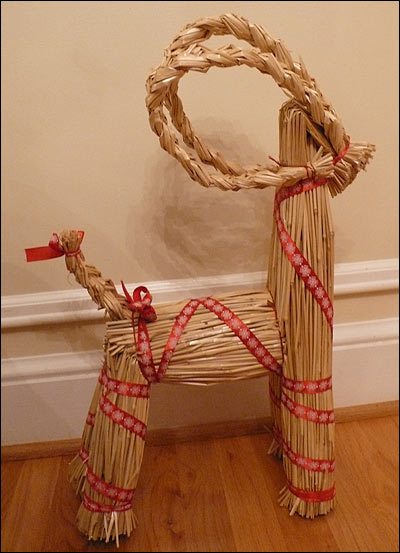
My husband feels I should include this link about the giant Julbocken i Gävle in Sweden.
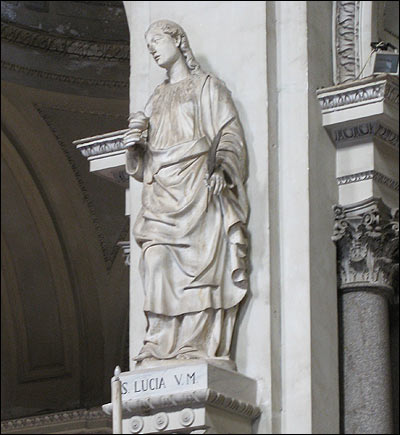
Without fail, every December 13th, my husband and I forget Santa Lucia day. Santa Lucia is a Sicilian saint. Above is a picture of a Santa Lucia's statue that my in-laws photographed during their trip to Sicily. The Scandinavians became acquainted with her when the Normans (men of the north) occupied Sicily. Santa Lucia is associated with light during the dark wintertime.
On the morning of the 13th, the eldest daughter of the house puts a wreath of candles on her head and serves coffee and Lucia buns to her family. Below is a Santa Lucia bun made by my Danish mother-in-law.
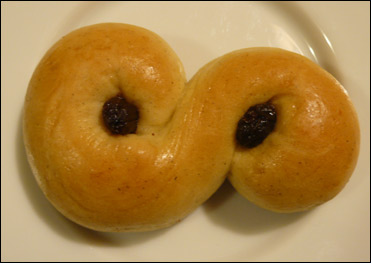
My mother-in-law tells me Santa Lucia is a Swedish and Norwegian tradition, and she only observes the day because her husband is Swedish. However, my mother-in-law bakes delicious Santa Lucia buns and brings them to our house every year to enjoy at Christmas. She also makes traditional Danish Christmas cookies: ginger snaps, vanilla rings and almond cookies. Very tasty.
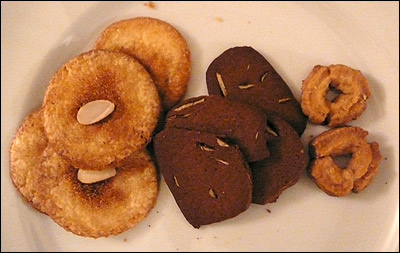
The next big day in the Christmas celebration is Lillejuleaften which means the evening before Christmas Eve. On this day, the grownups would cut down the Christmas tree, bring it inside, and decorate the branches with candles, glass bulbs, and the children’s paper decorations. In olden times, the children weren’t supposed to see the tree until Christmas Eve, however, now decorating the tree includes the entire family.
Typically, we have the tree set up before Lillejuleaften so we can concentrate on the smorgasbord. We have to shop at farmer’s markets, IKEA, and specialty grocery stores to gather various herrings, Greenland shrimp, smoked salmon, cold cuts, hard rye bread, schnapps, and a variety of cheeses including Fontina, Havarti, Port Salute, blue cheese and others. The sandwiches are open faced so the breads have to be strong enough to support loads of herring, egg, caviar and other yummy things. My father-in-law tells me that the schnapps is drunk for affect, not taste. The strong spirits warms and cheers you, but must be chased with beer, else it will burn your throat. Back in the day, there was formal drinking or open drinking at smorgasbords. Formal drinking means you must drink when the host does. My father-in-law contends this is how the Danes drank the British under the table. He also says that the advantage to formal drinking was no Viking could cut your throat as you drank. There are two sizes of schnapps glasses: large Swedish and small Danish.
At the smorgasbord, the guests make a sandwich with fish and then wait for the host to Skål, a Scandinavian toast for good fortune andhealth. Skål means drinking vessel but my family claims the term actually means drinking out of the skull of your enemy. Then the host welcomes everyone and wishes them happy glaedelig jul.
A proper smorgasbord should take several hours. The last course is coffee. Then the family and friends take a walk in the snow or such and gather a few hours later for a supper of pork loin, potatoes and red cabbage.
In Denmark, you eat a light breakfast and lunch on Christmas Eve or Jule aften because the kitchen is taken up preparing a goose stuffed with prunes and apples soaked in Port. The bird is accompanied by more potatoes and red cabbage. For dessert, you have rice, almond and cream pudding topped with hot cherry syrup. (I have a recipe if anyone is interested.) You must be very careful when you eat this dessert, for it is really a treacherous family game. You see, hidden in the pudding is one whole almond. The lucky family member who gets the almond wins a marzipan pig. In our home, in lieu of such a pig, we give out a chocolate orange.
Meanwhile, across the Kattegat in Sweden, Lutefish is served (or was). This, ummm, delicacy, is cod that has been cut by a carpenter saw and soaked in water and lye for months. Lutefish is tasteless except for the pepper and onion cream sauce and can turn your silver black. My husband gave me a little chemistry lesson on preserving fish. According to him, you have three ways to preserve fish. 1.) pickle it and make sil. 2.) let the fish rot and make surstömming. 3.) freeze dry. To reconstitute the dehydrated fish, you have mix it with lye and water and then wash away the lye.
The Swedes also had veal jelly with vinegar, pickled anchovies including the heads, and potato sausage made with pork, potato, and veal. After the meal was done and the dishes washed, glasses of Cognac were passed around.
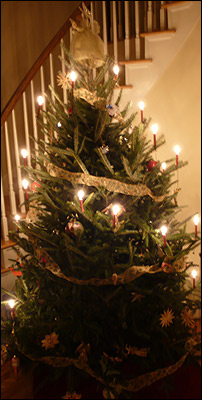 In Denmark, the grownups would open the door to the room housing the Christmas tree and let the children see the decorated tree with all the candles burning. Everyone danced around the tree and sang carols. (I have a CD of Danish Christmas music if you want to know the name). In our house, we light the tree candles, have a fire extinguisher handy, and keep the kids far away from the tree. We don’t keep the candles burning for very long.
In Denmark, the grownups would open the door to the room housing the Christmas tree and let the children see the decorated tree with all the candles burning. Everyone danced around the tree and sang carols. (I have a CD of Danish Christmas music if you want to know the name). In our house, we light the tree candles, have a fire extinguisher handy, and keep the kids far away from the tree. We don’t keep the candles burning for very long.
If you were Swedish, on Christmas morning you went to church at 5:30 to greet the sun while the Danes slept in. After church, the Swedes opened their gifts, ate ham for dinner and then took a nap. The Danes had another smorgasbord on Christmas and then continued to party for second Christmas day or Anden Juledag.
---------------------------------------------------------------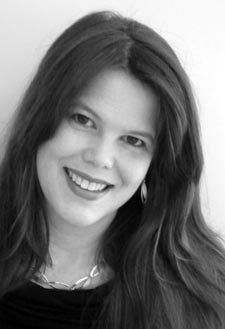
Susanna Ives is the author of RAKES AND RADISHES. You can learn more about her book at www.susannaives.com
Monday, December 20, 2010
i was the jukebox Review by Katrina

Sandra Beasley’s second book of poetry, i was the jukebox, catches your attention from the title, and doesn’t let it go ‘til the last line of the last poem. These 45 poems remind readers what good, timeless poetry is. If you think you don’t like poetry because you can’t understand it, read this book. Beasley will convert you. She has written real, honest poems that catch you off guard, insist that you pay attention, change the way you think. Love poems to college, oxidation, Los Angeles, and Wednesday in this collection, nestle among poems written from the voices of the Minotaur, piano, platypus, eggplant, orchis, sand, and the world war. Though there are three whose titles begin “Another Failed Poem About…” there are no failed poems here.
I was hooked as soon as I read the first lines of “The Sand Speaks,” the book’s initial work: “I’m fluid and omnivorous, the casual/ kiss. I’ll knock up your oysters.” “I’ll knock up your oysters” forces you to stop and evaluate what you just read, and it’s a line that readers will remember. The final line of the book’s last poem, “Proposal” is no less thought-provoking: “Promise you’re worth my weight in burning.”
Time and again, as I read and reread, I stopped to think and reorient myself to the way I fit in the world. It is a gifted poet who can do that several times in a series of poems. It is an amazing poet who can do it as many times as Beasley does in this work. Her Bernard Women Poets Prize is well-earned.
Friday, December 17, 2010
Best of 2010 BlogFest
Angelina Rain at Author in Training is hosting a blogfest over New Year's. Everyone is invited! Between singing Auld Lang Syne off-key and champagne toasts, come share your best or most bizarre 2010 accomplishments along with your goals for 2011. One of my 2011 goals will be to not consume an entire Belgian chocolate bar in one sitting. Seriously.
Go to Angelina's site for more details, the shiny graphic, and to sign-up on the linky link. Click here!
Happy Friday!
Wednesday, December 15, 2010
Thursday's Recommended Reading from K. Cat
"In a stone cottage, deep in a dark and entangled forest, sat a tall, thin woman in a high-backed chair. She drummed her bony fingers slowly on the chair's thick arms, her black eyes roaming the room. She had inky black hair with a few streaks of gray and her high cheekbones were heavily pronounced under her sickly pale skin. Her name was Mora . . . and she was waiting."K's copy is scratched and stained on the cover, its spine bent, its pages somewhat less than crisp and pristine. It is obviously a well-loved book.
* * * * * * * * * * * *
You can read more about The Unicorn Girl or LeGette's second novel For The Kingdom at her website: http://www.mllegette.com/default.html.
When Little Plastic Animals Attack
Monday, December 13, 2010
Review of THE NIGHT BEFORE, a holiday novella by David Fulmer
 THE NIGHT BEFORE by award-winning writer David Fulmer is a story about years of broken dreams and mistakes culminating on one Christmas Eve. From the beginning, the reader knows that this Christmas Eve is special. Fulmer writes, “The storm began late in the afternoon after the sky had darkened from crystal blue to cobalt, delivering snow on Christmas Eve for the first time in seven years.”
THE NIGHT BEFORE by award-winning writer David Fulmer is a story about years of broken dreams and mistakes culminating on one Christmas Eve. From the beginning, the reader knows that this Christmas Eve is special. Fulmer writes, “The storm began late in the afternoon after the sky had darkened from crystal blue to cobalt, delivering snow on Christmas Eve for the first time in seven years.”The main character is a novelist named Joe Kelly. He is a good man, an excellent parent and loving husband. Yet, his writing career has been on the skids for several years. He has had rely on his wife’s lucrative salary to support their family. As Christmas approaches, he gets a small bit of luck: his book is optioned by Hollywood. With money in the bank, he buys his wife Mariel an antique piece of jewelry that she remembered from her childhood: an Epiphany Star. Coming home with his present in his pocket, he finds Mariel having a tryst on the dining room table with their neighbor Don.
Crushed, Joe runs into the night and embarks on a series adventures involving strangers and old forgotten friends.
Fulmer excels at creating sensually tactile stories. The reader feels soaked in his settings. In this novella, he captures that eternal yearning for old-fashioned Christmases that probably only existed in Hollywood movies. Yet, this isn’t a saccharine holiday story; it is a gritty tale of broken people who cling to hope in the bleak midwinter. The characters are complex and sympathetic in their failings. The reader even feels empathy for the cheating wife.
Fulmer’s writing is lyrical. Reading his works evokes the emotional response of listening to music.His words are almost poetic without being over-the-top.
I highly recommend this book if the shallow, over-commercialized tales of Christmas leave you empty and desiring something “real.”
reviewed by Susanna Ives
Friday, December 10, 2010
Interview with Rebecca Johns, Author of The Countess
 eleased new novel, The Countess, a fictional memoir about the Hungarian noblewoman who was the archetype for many vampire stories. Johns speaks to us about the excitement of doing research for her work and writing about a much misunderstood character in history.
eleased new novel, The Countess, a fictional memoir about the Hungarian noblewoman who was the archetype for many vampire stories. Johns speaks to us about the excitement of doing research for her work and writing about a much misunderstood character in history.
LV: What inspired you to write about Countess Bathory? What was the trigger that drew you in and kept you interested?
After writing Icebergs, a book about ordinary people and their lives, Bathory appealed to me because of the extraordinary nature of her life. She came from one of the most wealthy and powerful families in Eastern Europe; she was given an extraordinary education for her sex and for the times. And of course she was accused of the most awful crimes anyone could imagine.
Yet in many ways her life was entirely recognizable to me. As a woman who struggled with infertility for ten years the same way the countess did, I sympathized with her. And then when I read how she lost two of those longed-for children to the plague, including the heir who would have protected the family name and fortune, I wondered, how could any woman survive such a loss? What would it do to the psyche to lose, and lose, and lose again everything and everyone you loved?
She was a contradiction. And the more I read, the more I realized how little of that contradiction had been explored in literature. She's been Lady Dracula, cackling and wielding her whip, and she's been the poor victim, a powerless woman taken advantage of by the men in her life. But the more I read, the more I realized the truth was probably somewhere in the middle. That's where I wanted to go.
LV: Your version of Bathory is more compassionate and complex then the accounts of her sprinkled all over the Internet. Was it difficult to do research for this character? What were some of the most interesting challenges you ran into when trying to uncover the real story?
RJ: The biggest challenge in researching the story of Bathory is the sheer volume of misinformation about her that exists. People take as gospel the stories of her bathing in the blood of virgins, or the stories of her diary of 650 victims, and those two bits of fiction have proliferated and spread, so that even otherwise "serious" historical works have not, until very recently, challenged those old lies. The blood-bathing rumor, for example, came from a single line of text in the trial documents that said she got blood on her clothes and needed to change her blouse. (Blood-bathing is technically impossible at any rate; the liquid congeals and separates outside the body.) The rumor of 650 victims came from a single witness who had it secondhand from someone else. Yet those two stories are the ones repeated about her most often. They're interesting, of course, but not realistic, and I knew that if I was going to write another book about her, it was time to put those old stories to rest.
The other challenge is the language barrier. Hungarian is a notoriously difficult language--the pronouns, for example, are gender-neutral, which makes translating the trial testimony into English a nightmare. Modern translations that attempt to be a bit more neutral and recreate the language with more precision are more useful than the older ones (like Valentine Penrose's poetic but probably biased translation) that use a bit more creative license.
LV: What was the most interesting piece of research you found?
RJ: There were two bits of information that I thought were particularly fascinating from a writer's perspective. The first was that after Bathory's arrest, the palatine's wife Erzsebet Czobor came to Csejthe and stole Bathory's jewels. The Lord Chief Justice even had to intervene with the palatine on the family's behalf, and the Chief Justic was no fan of the Bathorys. That seems to suggest pretty strongly that there was more to the story than the official account.
The secon d was a translation of a letter from Bathory herself, in which she threatens a neighbor who, thinking he could get away with it, took over one of the family's unoccupied estates. It was interesting not only to realize how precarious her situation was, but the tone in it was so like the voice I'd already created for her, I knew I was on the right track.
d was a translation of a letter from Bathory herself, in which she threatens a neighbor who, thinking he could get away with it, took over one of the family's unoccupied estates. It was interesting not only to realize how precarious her situation was, but the tone in it was so like the voice I'd already created for her, I knew I was on the right track.
LV: Your first novel, Icebergs, was also a historical novel, based on three generations, from War World II, through Vietnam, and finally to modern times. Would you say that history inspires you? Or what connects these two novels if anything at all?
RJ: Both novels are about family, about the effects of one generation on the next. They're both about war and its aftereffects. And they're both about the disappointments of love and how the human heart manages to continue despite those disappointments. The outside trappings might be very different--Wo
rld War II and Vietnam vs. the Ottoman wars, ordinary 20th-Century Canada vs. exotic 16th-Century Eastern Europe--but the themes are really incredibly similar.
LV: What’s coming up next for you? Can you give us a hint on your next novel?
RJ: My next novel is in the very early stages, but let's just say it's a turn for the contemporary, and that it's likely to include an element of the fabulous. More than that I wouldn't want to say.
Rebecca Johns's first novel, Icebergs, was a finalist for the 2007 Hemingway Foundation/PEN Award for first fiction and a recipient of the Michener-Copernicus Award. Her second, The Countess—a fictionalization of the life of Elizabeth Bathory, the “Blood Countess”—was published in October 2010 from Crown Books. Her work has appeared in Ploughshares, the Harvard Review, the Mississippi Review, the Chicago Tribune, Cosmopolitan, Mademoiselle, Ladies' Home Journal, Self, and Seventeen, among others. A graduate of the Iowa Writers' Workshop and the Missouri School of Journalism, she teaches in the English Department at DePaul University in Chicago.
Thursday, December 9, 2010
Jenny Schwartz talks about her awesome new eBook ANGEL THIEF
Today the Mojito Literary Society welcomes the talented Jenny Schwartz to talk about her latest release from Carina Press ANGEL THIEF. After reading this post, be sure to stop by her awesome blog Acquiring Magic: http://www.acquiring-magic.blogspot.com/
--------------
Hi everyone! It's so lovely you're letting an Aussie post here. I promise to mind my language and keep the kangaroos under control.
"Angel Thief" gave me a chance to share the romance of the Australian Outback with international readers, but it also reminded me how lucky I've been in my own experience of Australia.
I grew up in a small community on the outskirts of the suburbs. Preparing this blog post I stopped to think of the pets my friends and I had. It's actually pretty impressive, although my family generally limited itself to a dog (the fish couldn't survive Mum's cleaning regime).
There were horses, dogs, cats, a grey kangaroo, an emu, a peacock, budgies, lovebirds, wieros, cockatoos, ferrets, guinea pigs, rocks (did that craze for pet rocks hit American shores?) and hermit crabs. I don't think silk worms count as pets, but they were around too. Fortunately, there was a huge mulberry tree across the road from the school, so they had plenty to eat.
I'm mid-thirties, which I wouldn't call old, but my generation certainly had the last of the freedom. We could leave home in the morning and go wandering through the bush or visiting friends and no adult would worry about us. We knew everyone in the neighbourhood and everyone knew us. The track in the photo above is the sort of trail we'd follow to our "secret" hideouts.
The community is gone now, wiped out to make way for a new industrial centre. The people who lived there have scattered, but when our paths do cross, there is an immediate sense of connection.
So that's my nostalgia moment. Tell me about yours. What do you remember from your childhood that makes you smile?
Angel Thief, from Carina Press
She’s breaking the rules. Again.
An archivist in the heavenly library, Sara must follow protocol when it comes to curating the knowledge of the universe. But "liberating" an ancient text from the collection of a human—an Australian drug lord—could save a boy’s life. Sara has no way of knowing that one of the man’s other treasures is a sexy-as-sin djinni, bound by a wish to guard the estate.
He’s only following orders.
Filip is compelled to turn over intruders, even celestial ones, to his master. When he catches Sara in the library, he isn’t above indulging in some sensual kisses with her, or using her to trick the mobster into wasting a wish. It’s what he must do to preserve his facade of freedom and protect his heart.
But the kidnapping of the drug lord’s daughter forces Sara and Filip to work together—bringing out the hero that lurks within the soul of the djinni, and the passion within the angel.
***
You can find Jenny:
at her website http://www.authorjennyschwartz.com/
blogging http://www.acquiring-magic.blogspot.com/
or on Twitter @Jenny_Schwartz http://twitter.com/jenny_schwartz
Wednesday, December 8, 2010
Susan and Tina on Sloooow Writing
Jane rushed to the ancient door; its hinges creaked when she pulled the knob.
Jane hurried to the ancient door. The rusty iron hinges creaked as she pulled the knob.
Jane rushed to the door. When she pulled the knob, the ancient iron hinges let out a sigh.
Miracles occur.
If you care to call those spasmodic
Tricks of radiance
Miracles. The wait's begun again,
The long wait for the angel,
For that rare, random descent.
Saturday, December 4, 2010
Fiction Writers Review Interview with Susanna Daniels
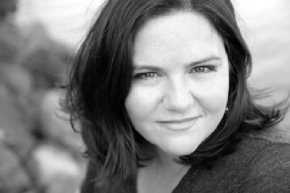
A Texture the Facts Can’t Convey: An Interview with Susanna Daniel
BY LAURA VALERI
I recently had the pleasure of talking with author Susanna Daniel about her debut novel, Stiltsville (HarperCollins, 2010). A fictional memoir about the span of a long marriage, this book is set in the real neighborhood of Stiltsville, which is built of stilt houses over the ocean on the periphery of Miami. The novel was voted one of Amazon’s Best (August 2010), was chosen as a Barnes and Noble Discover Pick, and has received wide critical praise. Daniel’s short fiction has been anthologized in Best New American Voices and published in One Story, Epoch, the Madison Review, and SignificantObjects.com.
In the following conversation, Daniel shares her insights on the process of writing, the power of quiet stories—which she terms eminently readable—and the perseverance and faith that writers must nurture for their own work.
Go to Interview
Friday, December 3, 2010
Laurie Lovell's Lovely Non-Lin Art

I consider myself lucky to know so many talented people. I'm proud to present my friend Laurie Lovell's art work. These lovely pieces were recently for display in a downtown Savannah shop/art gallery.
Hands off the basket (titled nest): that one has my name on it, but friends, I have two of Laurie's window chakra non-lin hangers and they are be-au-tiful (see Laurie's picture: those things hanging behind her are kind of like mine).
Below is Laurie's artist statement and some of her work. Just in time for Christmas shopping. You can contact her at lovelldesign@yahoo.com for a catalog and pricelist. Or just stop downtown at Cafe Gelatohhh and say hi to Laurie in person. She's a lovely person. You won't be sorry.
Artist's Statement:
This body of work is constructed of "Non-Lin" material process I developed to create a paper-like material from linen flax. Non-woven, non-spun long flax fiber worked with water and an adhesive to form a fabric that can be molded and presented both two-dimensionally and three-dimensionally. I have utilized additional textile techniques in these works to create a texture-depth and interest.
My goal is to create art objects that project a contemplative feeling with an underlying connection to the natural world. In my creative process, I transform what I observe into tactile imagery utilizing the language of visual communication: texture, line, light and shadow, color, form, space, and repetition.







Laurie Lovell can be contacted at lovelldesign@yahoo.com. She is the lovely lady in the picture above.

Wednesday, December 1, 2010
Kicking In The Window
I've certainly kicked in my fair share.
A few years ago, after wallpapering my office wall with rejection letters from agents and editors, I decided to submit a few short stories to magazines and online publications. I was so glad I did. That experience was like a shot in the arm for me personally and professionally.
It was nice to hear, "Wow! I loved your story. Got any more?" Lest you think it was all wine and roses, I certainly heard plenty more of "Thanks, but no thanks" but it kept me going.
While magazines and online publications pay very little, if at all, it was still a good way to make new contacts, get new perspectives on my writing and, yes, even get published every once in a while. It was also a welcome addition to my agent query letter when I could close with "I've had short stories published in X and Y." Now, of course that doesn't mean a hill of beans unless the query knocked the socks off an agent but perhaps it gave one or two of them pause to request a partial or a full of my manuscript.
What about you? What have you done to kick in a window? Anything unusual or not so unusual that you can recommend?
Tuesday, November 30, 2010
Interview with Amy Corwin, author of VAMPIRE PROTECTOR
1. Tell us a little about VAMPIRE PROTECTOR.
3. You mention that you are a former biology student (which explains why you can offer such a useful timeline on both corpse decomposition and Regency rose-growing). How else does your former scholarly interest affect your writing?
5. Your website also features articles from the broadsides, what you describe as the Regency’s version of tabloids. What do you find so fascinating about these sensationalistic accounts of horrid apparitions and murdering publicans?
7. Any other exciting news you'd like to share?
********************
Amy Corwin is a charter member of the Romance Writers of America and has been writing for the last ten years in addition to managing a career as an enterprise systems administrator in the computer industry. She writes Regencies/historicals, mysteries, and contemporary paranormals. To be truthful, most of her books include a bit of murder and mayhem since she discovered that killing off at least one character is a highly effective way to make the remaining ones toe the plot line.
Amy's first paranormal, VAMPIRE PROTECTOR, debuted in November, 2010.Amy’s first Regency, SMUGGLED ROSE, received a 4-star review by “The Romantic Times” and her second Regency, I BID ONE AMERICAN, received a perfect score of 5 from Long and Short Reviews. Her third Regency, THE BRICKLAYER’S HELPER, is out now from The Wild Rose Press.
Website: http://www.amycorwin.com
Twitter: http://twitter.com/amycorwin
Facebook: http://www.facebook.com/AmyCorwinAuthor
Blog: http://amycorwin.blogspot.com
Monday, November 29, 2010
Tina's Review of SHADOWS OVER PARADISE by Anne K. Edwards
Friday, November 26, 2010
Talking Chocolate with Denise, Foodie and Chocolate Enthusiast
I'm thrilled that my friend Denise Chiavetta agreed to visit the Mojito Literary Society and share her passion (addiction) to chocolate. Aside from being a die hard foodie and member of the artisan slow food movement, Denise is a professional futurist. She studies trends in technology and their potential impact on industry and culture. In other words, Denise is a badass. Her knowledge of the history and processing of chocolate is quite impressive.
* You have a Tshirt that reads "life begins after 70 percent." Can you explain what that means?
I've had people ask me all sorts of questions about it, such as "is that the passing grade for the bar?" I'm not sure according to what governing body, but chocolate with at least 70% cocoa solids is "dark" chocolate, the consumption of which is one of the very good reasons to be alive.
* Can you give a quick overview of the process of making chocolate?
Cacao pods are filled with a sweet pulp and bitter seeds (cacao beans).
After harvest, the sticky insides of pods are scooped out and allowed to ferment. Fermentation is what gives the beans their "chocolate"
characteristics, so it's an important step. Fermented pulp easily washes off the beans so they can be thoroughly dried and eventually roasted. Roasted beans are milled/ground into chocolate liquor. The next critical step is conching, which is basically more mixing, usually with other ingredients (sugar, milk, etc.). The longer you conch, the smoother the chocolate. To cut conching corners, some makers add an emulsifier like soy lecithin.
Finally, chocolate is tempered, which is basically controlled cooling to control crystallization. Tight tempering ensures a snappy but smooth, glossy chocolate.
*What makes a good chocolate?
The same things that make good wine......varietal, terroir, handling, storage, etc. The vast majority of chocolate produced in the world is the forastero varietal, a very hardy and productive plant that produces bitter and not very complex beans. Rarer is the fragile and less productive but sweeter and more complex criollo varietal. Trinitaro is a hybrid of the two.
There are so many points "farm to table" (or in this case, maybe farm to
finger) to "show some love" rather than "take the money and run" that significantly impacts quality. Chocolate love includes harvest of ripe pods, ample time for fermentation, even and careful roasting, patient conching and tempering, etc.
*If I wanted to be a chocolate connoisseur, what terms would I need to know?
I would say definitely conching and tempering. While a crisp snap emits from the chocolate you just broke in two, say "this glossy, snappy chocolate was perfectly tempered."
*Why is it important to know the source of cocoa beans in your chocolate?
For two reasons. Since the early steps of the farm to finger process (varietal planting, harvesting, fermenting) happen at the source, knowing who's hands were involved and what decisions they made makes for a quality experience. The second reason is that like all tropical commodities (coffee, sugar, chocolate) from the southern hemisphere, production is steeped in a tragic history of exploitation of people and land. Purchasing a chocolate with a fair trade certification ensures chocolate spreads love.
*Recently you've become interested in how the Aztecs made chocolate. Can you explain a little more?
Having heard for so many years (from the common wisdom fairies) that chocolate was "the food of the gods" for the Aztecs, I decided to research the topic. Actually, it has a much longer history, beginning with earlier mesoamericans, but they all fermented, roasted, and ground the beans as is still done today. Each culture ground in a preferred spice combination. Hot peppers are still popular today, but they also used musky and savory spices.
Chocolate was always mixed with hot or cold water to make a drink. A significant aspect of what defined chocolate and the consumption experience was the froth created by pouring the chocolate liquid from one container to another from a fair height, i.e. standing while pouring into a vessel at your feet. Specialized vessels were used to pour. The froth could even be removed for final seasoning of the liquid, and then put back on. I really would like to go back in time and see what the froth produced by a palace expert was like :-)
* Who are some chocolatiers you would recommend?
There are so many, it's fun to explore. The empty wrappers currently strewn in my office are Amedei (Italy) , Coppeneur (Germany), and Vosges (USA).
*Is there a question I should have asked but didn't?
When is the best time of day to enjoy chocolate? Anytime :-)
Thursday, November 25, 2010
Bobbye's Holiday Book Recommendations
Dying for a Date by Cindy Sample
June 2010, L&L Dreamspell

Note from Bobbye-A laugh-out-loud funny romantic mystery. This is a keeper. Read with a glass of good Merlot.
Not sure if she is looking for Mr. Right, or Mr. Every Other Saturday Night, recently divorced Laurel McKay reluctantly joins THE LOVE CLUB, a matchmaking agency advertised as the safe alternative to on-line dating.
After Bachelor one decides he wants her for dessert, Laurel dispatches him with her cell phone. The next day she discovers her drop dead gorgeous date has literally dropped dead. When Bachelor two disappears during dinner, Laurel’s only alibi is a friendly bottle of Dom Perignon. The investigating detective has to decide if the sassy soccer mom is a killer, or the next target.
Magick Charm by Jennifer Wells
September 2010, Crescent Moon Press

Note from Bobbye-Take a solid paranormal romance, throw in a generous dose of humor, liberal dashes of thriller and toss gently for an exciting read. Read this with a margarita.
Janie Adler likes her quiet, orderly life reviewing books for a small New Orleans newspaper exactly the way it is. So what if Duke Hot Pants, the hero of her favorite romance novel, is the only man in her life? She has a Pulitzer Prize to chase. That is until her quirky twin sister Rachel moves in, bringing boyfriend drama, a smelly ferret, and irrational belief in all things magickal along with her.
Persuaded by a local voodoo priestess-and maybe one margarita too many-the twins cast spells to improve their love lives. Loser-magnet Rachel focuses on avoiding the wrong men and Janie seeks her romance novel ideal. While plenty of eligible bachelors flood into their lives, Janie only has eyes for her coworker who lives in the apartment downstairs and works in the cube next to her. But the twins soon discover the incantations' many unintended-and dangerous-consequences. The increasing number of mishaps and misfortune putting the sisters in grave peril seems more like the work of a curse. Can Janie and Rachel's "twintuition" save them from the menace stalking them?
Believe, Christmas Anthology 2010
November 2010, Turquoise Morning Press

Note from Bobbye-Eight uplifting short stories to read by the fire with an Irish coffee.
Second Hand Horses by Amy LeBlanc
Mall Magic by Cat Shaffer
Another Quirky Christmas by Tonya Kappes
Concourse Christmas by Margaret Ethridge
Love in an Elevator by Krista Ames
Fixing Christmas by Elizabeth Chalkley
Angel on Board by Janet Eaves
The Twelve Seductive Days of Christmas by Marissa Dobson
Have a great Thanksgiving, and I suggest you feel free to take a nap afterwards.










